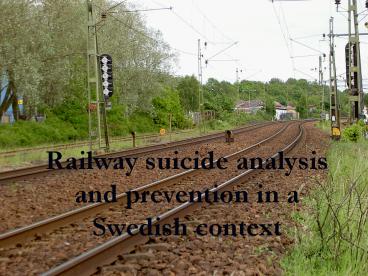Railway suicide analysis and prevention - PowerPoint PPT Presentation
1 / 32
Title:
Railway suicide analysis and prevention
Description:
Railway suicide analysis and prevention in a Swedish context Railway suicide analysis and prevention in a Swedish context By Helena R dbo, Ragnar Andersson, Inge ... – PowerPoint PPT presentation
Number of Views:255
Avg rating:3.0/5.0
Title: Railway suicide analysis and prevention
1
Railway suicide analysis and prevention in a
Swedish context
2
Railway suicide analysis and prevention in a
Swedish context
- By
- Helena Rådbo, Ragnar Andersson, Inge Svedung
- Karlstad University Sweden
- In collaboration with The Swedish National Rail
Administration Banverket
3
List of studies
- Suicide and other fatalities from train-person
collision on Swedish railroads A descriptive
epidemiologic analysis as basis for
systems-oriented prevention - Suicide Prevention in Railway Systems
Application of a barrier approach - Suicide and potentials for suicide prevention on
the Swedish Rail Network a qualitative multiple
case study - Feasibility of railway suicide prevention
strategies a focus group study
4
Background
- Suicide is a major public health problem
- More than 75 of all fatal train person
collisions are suicides - The dominating cause of fatal injuries in the
Swedish railway system
5
Aim of study 1
- To give an epidemiologic description of the
- railway suicide problem in Sweden
- To compare similarities and differences
- between suicidal and accidental
- train person collisions
6
Materials and methods
- Reports on fatal incidents available at the
Swedish National Railway Administration,
Banverket - Includes all fatal railway incidents in three
years 2000-2002
7
Sex of victim
8
Age
9
Daytime vs. night time
10
Urban vs. rural areas
11
Activity and movement pattern
12
Conclusion
- Victims normally trespass track area a good while
before train arrives - Incidents are highly concentrated to densely
populated areas - Suicidal and accidental incidents show many
similarities (from a preventive point of view)
13
Aim and Method study 2
- To theoretically derive and categorise a set of
- railway suicide prevention strategies
- Methodologically, generic accident and
- suicide prevention models were synthesized
14
Suicidal process model
Decision to enter tracks
Lethal outcome
Suicidal thought
Collision
System based preventive measures
Prevention related to presumptive victims
Modified from Beskow (1979)
15
Fault tree analysis Two basic conditions for
critical impact
Critical impact
and
Person on the tracks
Train with critical impact potential
and/or
and/or
16
Energy model
TRAIN (Energy source)
VICTIM (vulnerable target)
BARRIERS
After William Haddon
17
A combined list with barriers from both FTA and
Haddons 10 strategies
- Removal functions
- Speed limits
- Braking capacity
- Driver alerting (visibility, signals, etc.)
- Rail and surrounding structure design
- Front design
- Deflecting devices
- Wheel design
- First aid
- Health care
- Rehabilitation (physical and mental)
- Abolish rail transportation
- Reduce frequency and mass (regarding speed, se
below) - Increase individual and public knowledge on
existing barrier functions, survival rate, etc.) - Reduce spatial and temporal availability
- Physical barriers fences, bars, etc.
- Spatial barriers tunnels, elevated tracks
- Electronic barriers detection and alarm
functions - Human barriers professional or public
surveillance - Repulsive functions
18
Aim and Method study 3
- To evaluate existing police and rail
administration reports on railway suicide
incidents - To identify and categorize additional
preventive-oriented information - Method Multiple Case-study
19
Results
- Police and Railway administration usually collect
adequate background information on train, place
and victim - Missing details of relevance for the prevention
- Victims behaviour before collision
- Circumstances preceding the collision
- Characteristics of the location
20
Feasibility of railway suicide prevention
strategies a focus group study
21
Aim and Method study 4
- To analyse the acceptance of proposed
preventative strategies among relevant
professional groups - To validate and further develop these strategies
- Focus Group interviews
22
Model of measures
23
ResultsTheme 1, Category 1-3
- Measures reducing the attractivenessof railway
as a means of suicide - 1 The expected level of violence
- 2 Compensation
- 3 Availability
24
Results cont.Theme 2, Category 4-5
- Measures obstructing the accessibility to the
track area - 4 Noise barriers
- 5 Fences
25
Results cont.Theme 3, Category 6-8
- Measures influencing the victims determination
while awaiting train - 6 Information about the unlawfulness
- 7 Warning signals
- 8 Information posted at hot spots
26
Result
Results cont.Theme 4, Category 9-13
- Early warning systems, enabling the train to
brake sufficiently or the victim to be removed
before collision - 9 Camera surveillance
- 10 Patrolling
- 11 Public alertness
- 12 Calls from other train drivers
- 13 IR technology
27
Results cont.Theme 5, Category 14-16
- Measures to make the collision less violent and
thereby less fatal and injurious - 14 Speed
- 15 Braking capacity
- 16 Design
- Front, Axel box damper, Airbags
28
Practical implications, measures available today
- Informing the public on trespass prohibition
- Patrolling/surveillance at critical sites
(potential hot-spots) - Promoting public awareness and emergency calls
- Facilitating warning feedback from train drivers,
when they observe trespassers
29
Practical implications, measures available today
(cont.)
- Maintenance and improvement of existing fences
and noise barriers - Proper fencing (when lacking) in densely
populated areas
30
Practical implications, measures available in the
longer term
- Air bag (external)
- Redesigning level crossings
- Improving visibility with the aid of
IR-technology - Redesigning platforms
- Redesigning axel box dampers
- Warning alarm, triggered by the presence of the
victim - Improved train front design
- Magnetic brakes on more trains
31
Conclusion
- There is a general acceptance and understanding
of preventative principles - The results support the validity of the proposed
model for railway suicide prevention - No major additional categories were identified,
not covered by the model
32
Thank you for your attention
- Helena.radbo_at_kau.se































